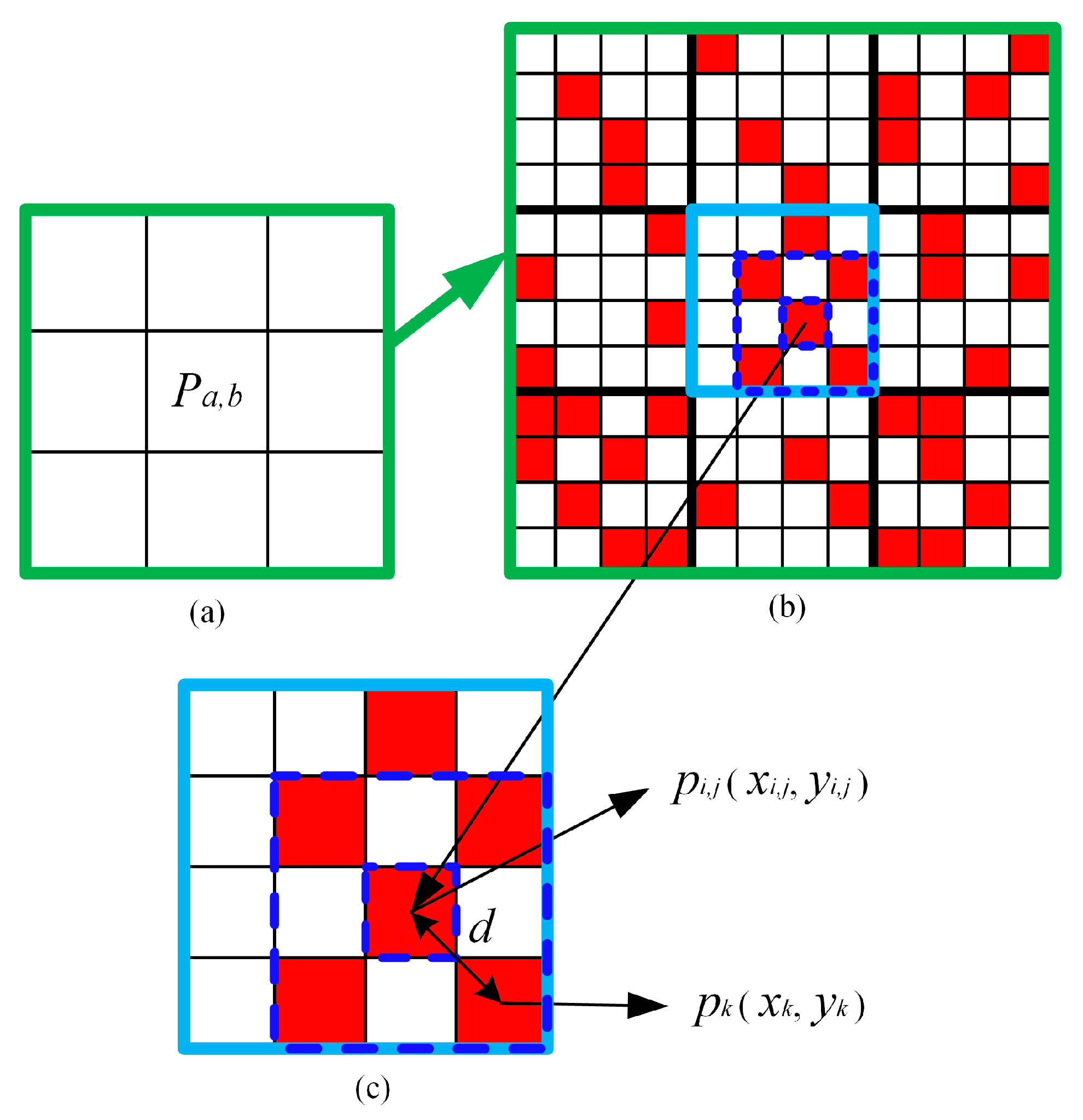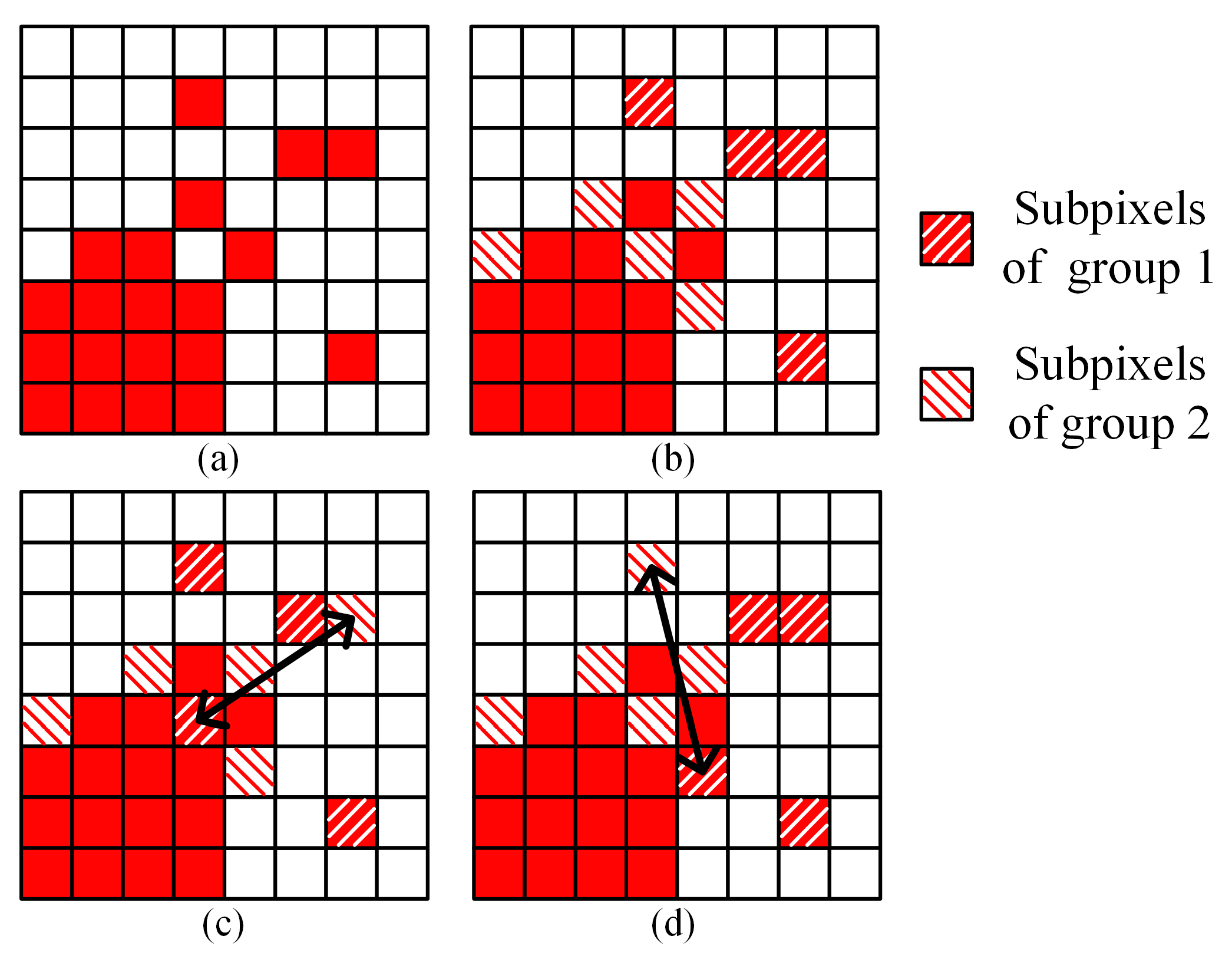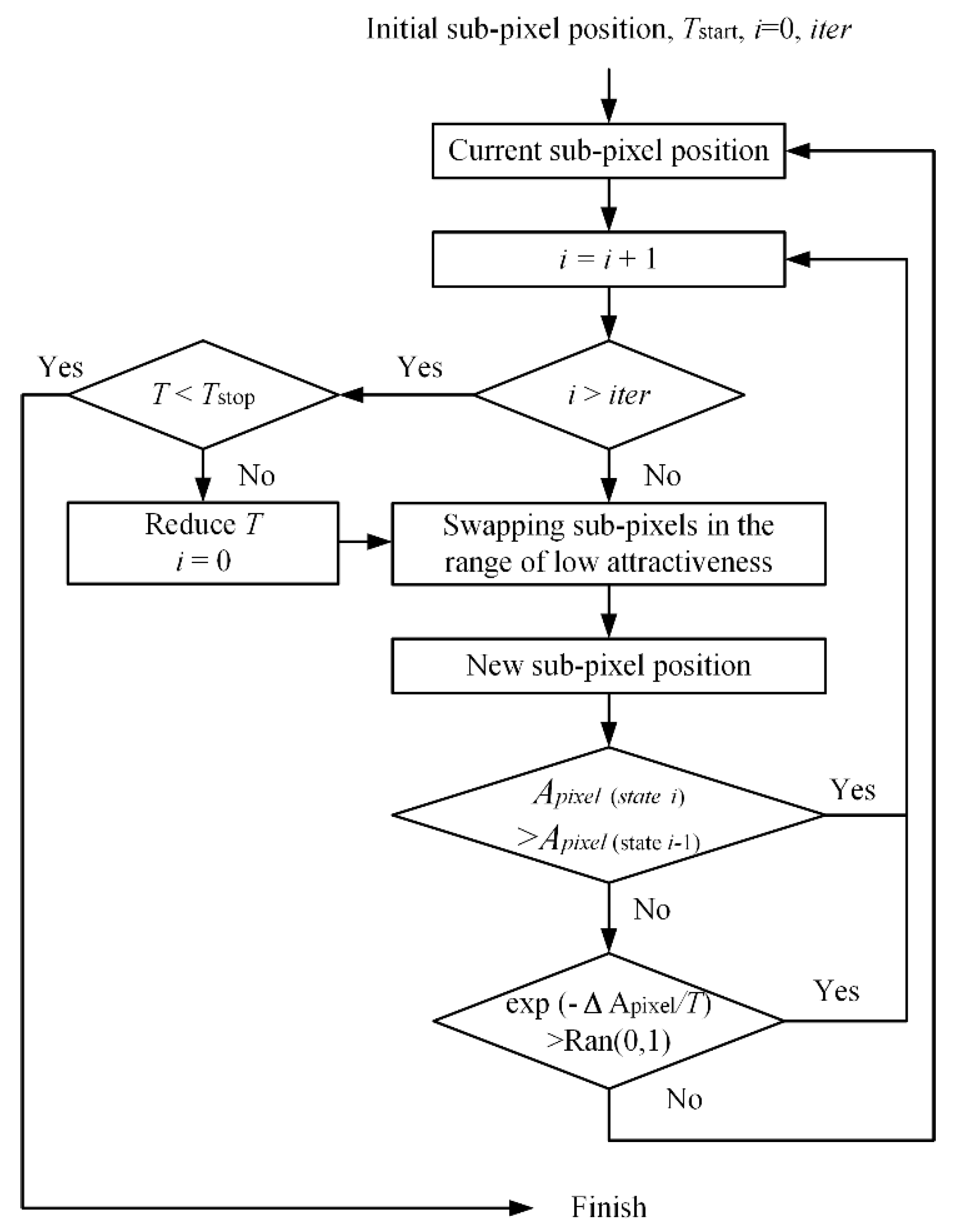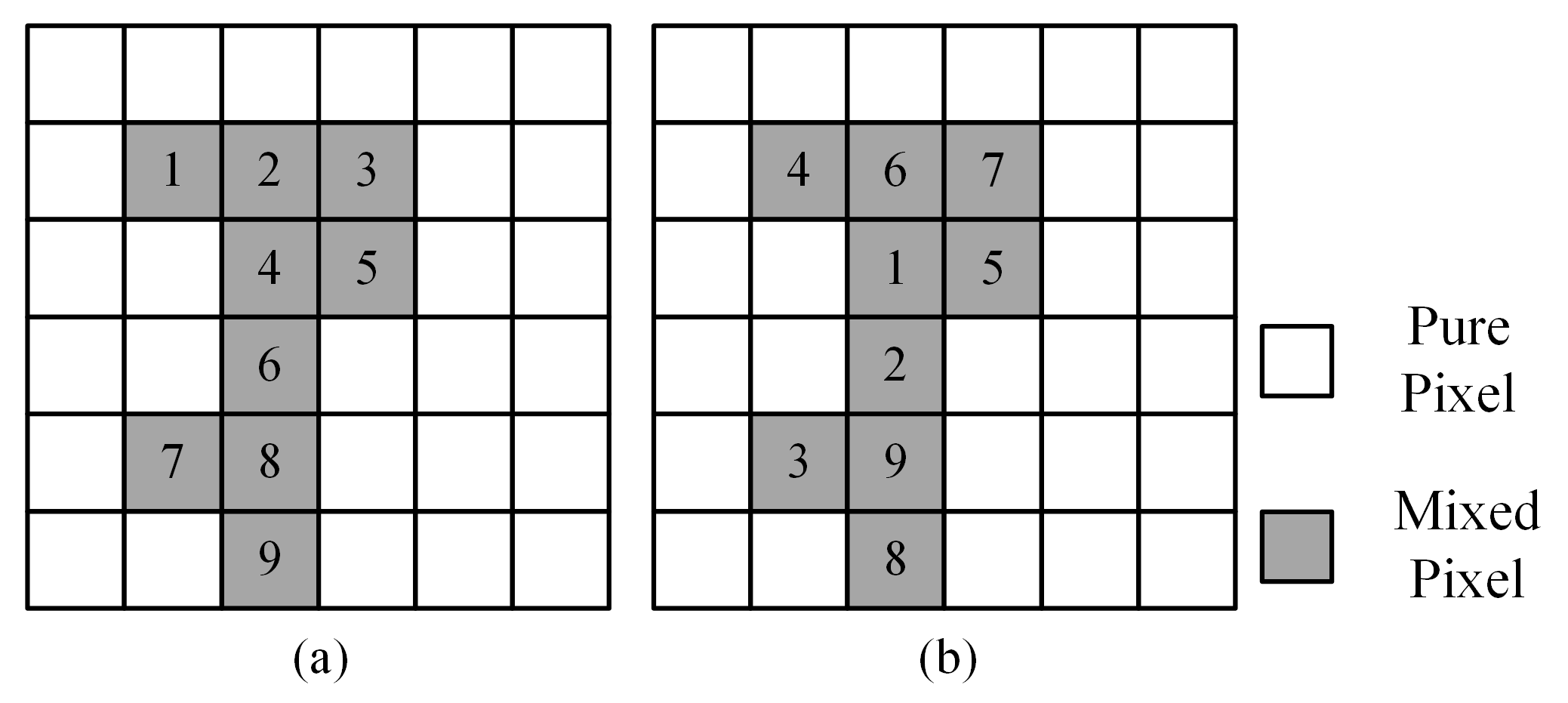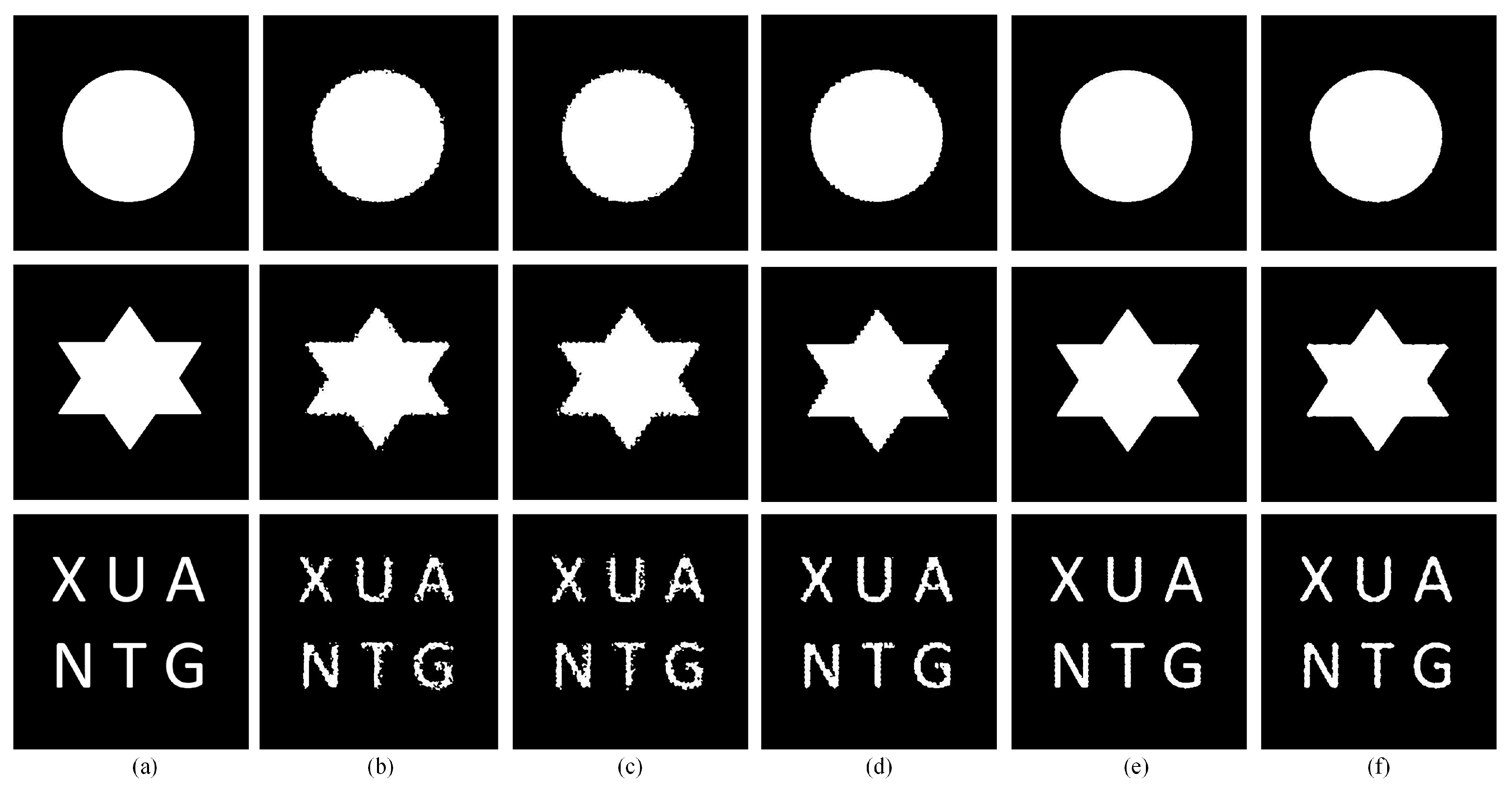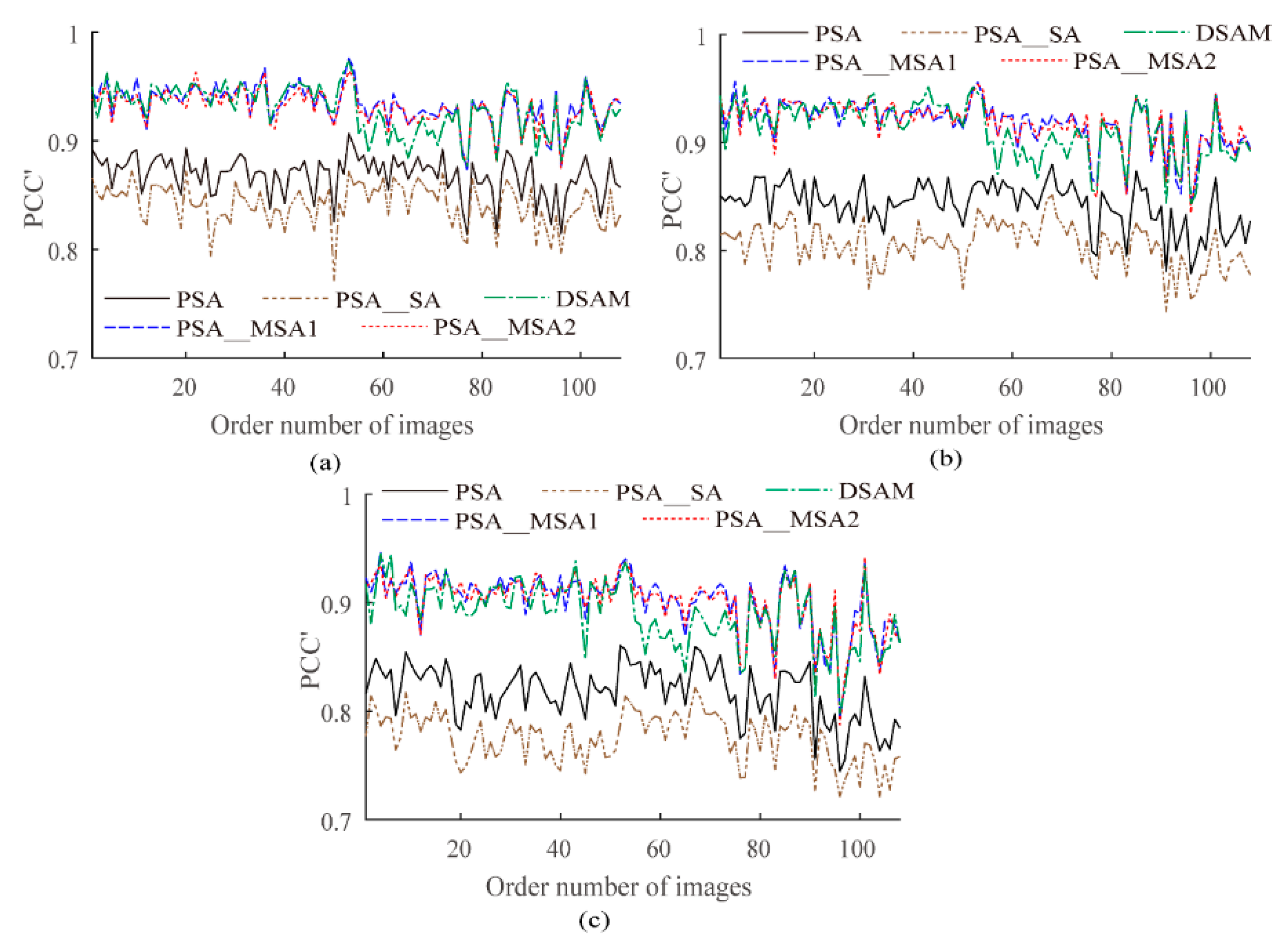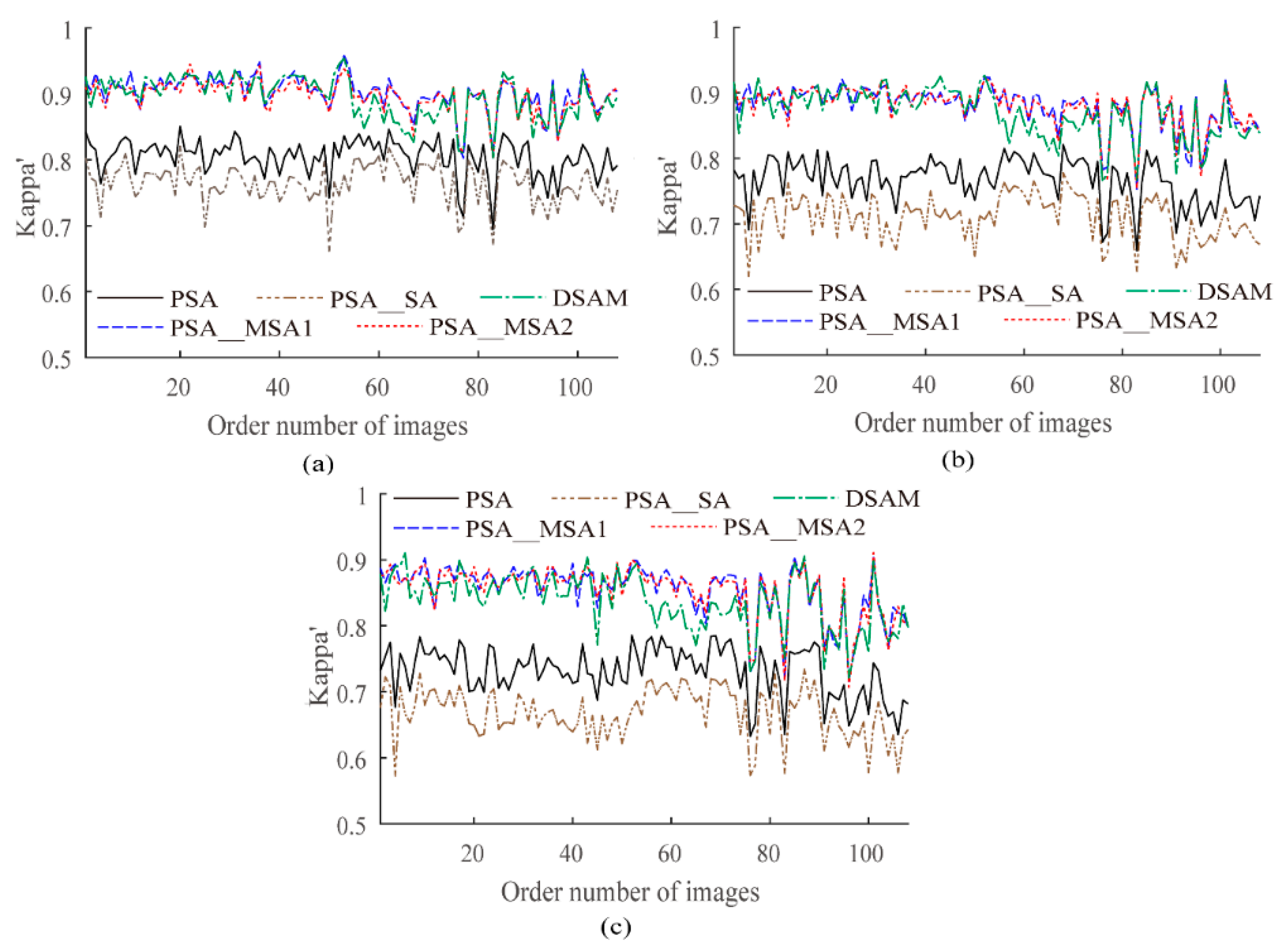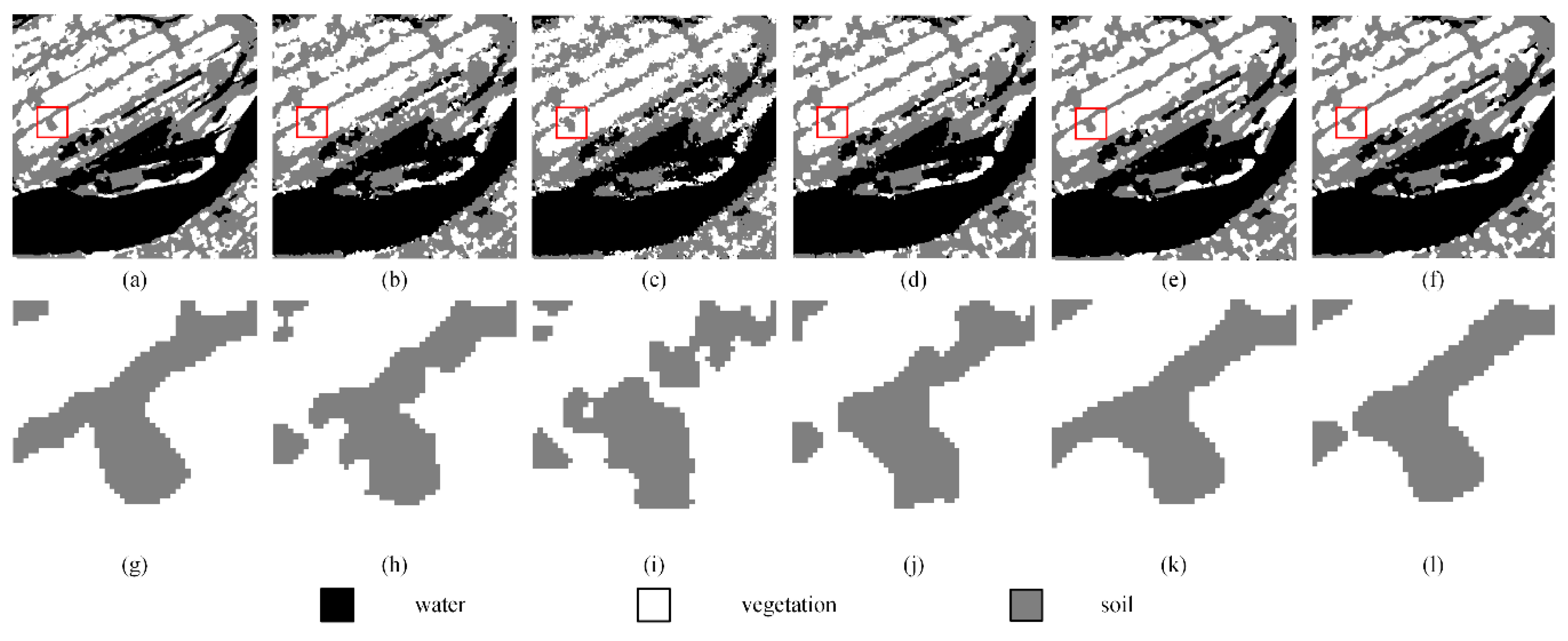2.1. Principles of the PSA
We begin with a brief introduction of the principle behind and the functions of the PSA. The PSA constantly exchanges classes of subpixels to ensure that the subpixels from the same object have the largest spatial correlation. The PSA consists of three steps. Some symbols are shown in
Figure 1.
Step 1. Calculate the gravitational value which reflects the spatial correlation of a mixed pixel. For a subpixel
pi,j located at (
i,
j), its gravitational value can be calculated as follows:
where
is the gravitational value of
pi,j,
N is the number of neighboring subpixels,
λk is the weighting function of distance, and z(
pi,j,
pk) is the And operation function.
The total gravitational value of a mixed pixel
Pa,b can be obtained by summing the gravitational values of all its subpixels
pi,j.
Step 2. Exchange the classes of the subpixels within the mixed pixel. For all subpixels of category 1, the subpixels with the lowest gravitational value are set to 0; for all subpixels of category 0, the subpixels with the lowest gravitational value are set to 1.
Step 3. Based on Equation (5), calculate the new total gravitational value of the mixed pixel. If the new gravitational value increases, then a subpixel-swapping result is retained. Otherwise, the locations of different land cover subpixels will return to the previous state.
Repeat step 1 to step 3 until the total gravitational value (Equation (5)) of the mixed pixel does not increase. The corresponding SPM results are considered to be the best localization results.
The current swapping method of the PSA is relatively simple, yet it is likely to fall into a local optimum solution of the objective function. To solve this problem, we introduce a SA algorithm to obtain the global optimum solution during subpixel swapping.
2.2. PSA with Simulated Annealing (SA)
The SA algorithm, which is used for solving optimization problems, was first proposed by Kirkpatrick et al. [
35]. It is based on a strong analogy between the issue of solving optimization problems and the physical annealing of solids, which leads a system to its lowest energy state. Thus, the SA algorithm has the ability to escape from the local optimum solution [
36,
37].
A simulated annealing process includes the following steps: (1) select an objective function and set the starting temperature (simulated melting point), (2) simultaneously reduce the temperature and decrease the energy of the objective function, and (3) repeat step (2) until the target temperature reaches the ideal temperature and the objective function converges to the minimum value.
Peng 32 directly applied the conventional SA algorithm to the swapping process of the PSA, and we refer to this algorithm as the PSA_SA. Peng used the spatial correlation to calculate the objective function used in the SA algorithm. The spatial correlation coefficients are calculated as follows:
where
N is the number of neighboring subpixels of each subpixel, while
is the And operation function.
The final target optimization function of one mixed pixel is the summation of the spatial correlation coefficient of each subpixel within this mixed pixel and is defined as:
The subpixel swapping process of PSA_SA is as follows: Randomly exchange the classes of subpixels in a mixed pixel, and calculate the new target optimization function ′ and the corresponding Δ=′ − . If Δ ≥ 0, the exchanged positions of subpixel land covers would be retained, and = ′. If Δ < 0, calculate the acceptance probability ε = exp(−/T) at the current SA temperature T, and compare ε with a random number r, which is in the range of (0,1). If ε > r, then the exchanged result would also be retained. Otherwise, the location of subpixels will return to the previous state.
Unlike the PSA, the PSA_SA contains an added SA algorithm, which has shown a great tolerance to local optima convergence and is often called a global optimizer that accepts deteriorated solutions with a certain probability in subpixel swapping [
38]. Thus, the PSA_SA should be able to help mixed pixels to get rid of the problem of the local minimum in the process of increasing their gravitational value through subpixel swapping. However, the constant random exchange in the SA algorithm makes it difficult to use the subpixels of various land cover types to establish a reasonable spatial distribution. Therefore, the accuracy of the PSA_SA is not ideal, which will be demonstrated in the experimental results in
Section 3.
2.3. PSA Based on the Modified Simulated Annealing Algorithm (PSA_MSA)
According to Atkinson, the purpose of the PSA is to maximize the spatial dependence, which is “the likelihood that observations close together are more alike than those that are further apart” 25, for subpixels of different land covers in a mixed pixel. To achieve this goal, his proposed PSA swaps the subpixels corresponding to the two types of land covers that have the smallest gravitational values. Peng’s method merely swaps two randomly selected subpixels from all the subpixels of different land covers. Although this method considers the spatial dependence among the subpixels, the swapping range in this method is too wide and therefore cannot obtain sufficiently accurate results within a limited number of interactions.
In this research, based on the spatial dependence principle, we propose a PSA based on the modified simulated annealing algorithm.
Figure 2a shows a mixed pixel with two kinds of land cover. Several subpixels with small gravitational values in the corresponding land cover form a group, and two groups of these subpixels are shown as slashed blocks in
Figure 2b. In the proposed method, the SA algorithm randomly selects only one pixel from each group and swaps their classes.
Figure 2c,d show two possible swapping results. This method constrains the subpixels, which are randomly swapped by SA, to subpixels with small gravitational values within their own classes.
The procedure of the proposed PSA_MSA algorithm following various steps:
Figure 3 illustrates the process of optimizing mixed pixels from step 1 to step 3 in the form of a flow chart.
Step 1. Initialization
According to the proportions of land cover in the mixed pixels, the subpixels with corresponding classes are randomly allocated in each mixed pixel. Calculate the total attractiveness of each mixed pixel by using either Equation (2) or Equation (4). Equation (2) considers the distance between the central subpixel and neighboring subpixels as the weight function, while Equation (4) treats neighboring subpixels with the same weighting value. We denote the algorithms based on Equations (2) and (4) as PSA_MSA1 and PSA_MSA2, respectively.
In the SA algorithm, set the values of the parameters such as the attenuation factor (a), the number of iterations (iter), the initial temperature Tstart, and the final temperature Tstop. The cooling function is defined by Tq+1 = Tq × a, where q is the number of cooling times which reflects the number of iterations and T0 = Tstart.
Step 2. Use the SA algorithm to randomly swap the selected subpixels
According to the principle of spatial relevance, we can only swap subpixels with low attractiveness. Therefore, a constraint is applied to the SA algorithm by selecting subpixels that need to be swapped with attractiveness values within a certain range.
The low attractiveness range of is defined as follows:
First, the subpixel gravitational values of two opposing classes are calculated separately. Here, we use M and N to represent two opposing classes. There are l subpixels in class M and S × S − l subpixels in class N.
Then, the gravitational values of M-class subpixels are sorted from smallest to largest:
<
< … <
< … <
(
m ≤ l; some subpixels may have the same gravitational value). Moreover, the gravitational values of N-class subpixels are sorted from smallest to largest:
<
< … <
< … <
(
n ≤
S ×
S −
l). In this research, the low attractiveness range for class M is [0,
], and the low attractiveness range for class N is [0,
]. Then, the swapping process can be expressed by the following formula:
where
is the attractiveness of subpixel
pi,j calculated by either Equation (1) or (3).
Calculate the new total objective function values ′ and ΔE = ′ − . If ΔE > 0, the new positions of the subpixels will be stored. If ΔE ≤ 0, compute the acceptance probability ε = exp(′ − )/Tq at the current MSA Tq. If ε > r, where r = rand (0,1), the new position of the subpixels will still be accepted. Otherwise, the locations of the subpixels will return to the previous state.
Step 3. Cooling system
Once step 2 is accomplished, i = i + 1. If i = iter, the system will be cooled by the cooling function: Tq+1 = Tq × a.
Repeat steps 2 and 3. The optimization of one mixed pixel will be stopped when Tq+1 < Tstop. All mixed pixels will be optimized via steps 1 to 3.
Step 4. Randomly optimize the mixed pixels a second time
The traditional PSA sequentially optimizes the mixed pixels, as shown in
Figure 4a. However, the experimental results show that sequential optimization may limit the accuracy of SPM, which may be due to repeated one-directional optimization. To change the optimization direction, we randomly adjusted the order of the mixed pixels, as shown in
Figure 4b and optimized the mixed pixels again following the same procedures described in steps 2 and 3. The experimental results in
Section 3.4 show that randomly optimizing the mixed pixels again is better than sequentially optimizing them.
Step 5. Winner-takes-all strategy
Since the SA algorithm uses binary optimization, only one type of land cover is optimized at a time. In each iteration, only the subpixels of one land cover type are set to 1 (pi,j = 1), and the pi,j for all the other subpixels are set to 0. To optimize all the land covers, steps 1 to 4 are repeated. After all land covers are optimized with the initial input proportional image, the corresponding class-specific attractiveness of the subpixels is calculated. Thus, each subpixel stored the attractiveness values corresponding to different types of land covers. Comparing the attractiveness values of all kinds of land covers within a subpixel, the subpixel will be classified according the land cover that has the largest attractiveness value 15.
